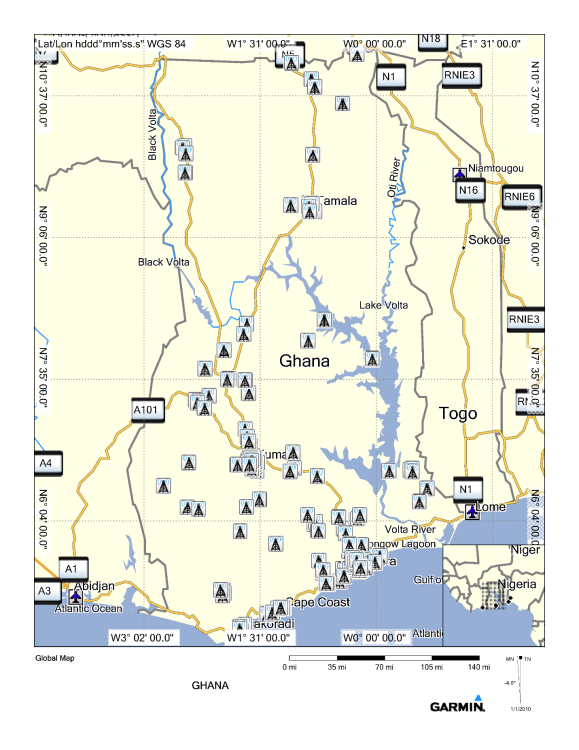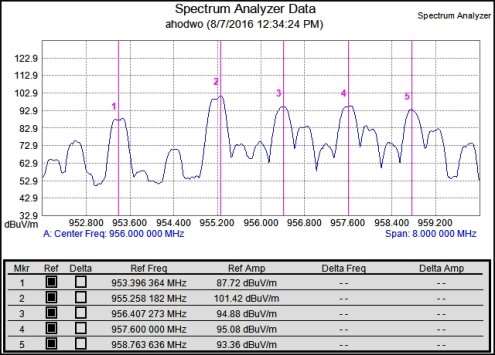CHAPTER FOUR
3.5 EXPERIMENTAL DESIGN

Figure 4.1: Setup during measurement
In this research work, the choice of instrument operation and parameters were established by quality assurance procedures. The following measurement parameters were investigated. These were: input attenuation, signal detection methods, resolution methods and measurement hold methods. The result of the quality assurance procedures are shown at the appendix. The study to measure and analyze power density levels was carried out with a total of 200 sites across the ten regions of Ghana as shown on table 4.1 below. The selection of the site for measurement was based on proportional sampling using mobile cell site population as well as the 2010 population census data. The measurement taken a location was always closer to a cell site than any other sources. The design of the measurement procedures was based on the Electronic Communication Committee (ECC) (ECC, 2007) protocol. A calibrated USA Anritsu Spectrum Master MS2720T with a serial number 1338067 and a frequency range of 9 KHz to 43 GHz was connected to a calibrated hand-held Transformational Security (TS) Log-periodic antenna TS-6021 with a serial number 00302 and a range of 750 MHz to 3 GHz by an Anritsu RF cable with a serial number 39317A. A magnetic Global Position System (GPS) connected to the Spectrum Master takes the location coordinate during measurement as shown in figure 4.1 above
Table 4.1: The distribution of 2010 population and sample sites (15 analogue terrestrial stations
|
Region of Ghana |
Population (2010 census) |
Number of FM (June, 2015) |
Number of cell site |
Number of measurement site |
Sampling Date |
|
Greater Accra Ashanti Eastern Central Western Volta Brong Ahafo Northern Upper East Upper West |
4,019,388 4,783,812 2,638,494 2,194,635 2,367247 2,120,659 2,317929 2,490541 1,035671 690,447 |
45 43 32 25 46 27 50 24 12 9 |
4041 2377 832 832 1189 594 832 713 238 238 |
68 40 14 14 20 10 14 12 4 4 |
September,2014 July,2014 June,2015 July,2015 September,2015 August,2014 November,2014 October,2014 October, 2014 October, 2014 |
.
The sampling towns and location were pre-determined as plotted on the map in figure 4.2. These locations were mostly regional capitals and some surrounding towns and villages.

Figure 4.2: GPS location showing places where radiofrequency measurements were made indicated by the tower symbols on the map
The measurement at a spot involve taking measurement at three different heights: 1.0, 1.5 and 1.7 m above the ground. This is illustrated by the ECC raster below in the figure 4.3 below.

Figure 4.3: Revised ECC recommendation (02)04 proposed raster
Measurements with the antenna was taken in two perpendicular plane at each height, with the axis of the antenna directed toward the reference cell site. A set of mutually perpendicular polarization measurements leads to the estimation of the maximum field arriving from a specific direction irrespective of its polarization. The measured field strength in dBµV/m from the spectrum data was corrected and converted to linear value using equation 4.1 and to V/m using equation 4.2. Figure 4.4 below shows a typical spectrum master measurement in the vertical plane that was taken at a town named Ahodwo in the Ashanti Region of Ghana.

Figure 4.4: A typical spectrum master measurement taken at Ahodwo, a location in the Ashanti Region.
Where  is the corrected electric field strength for cable and antenna loses taking polarization into consideration.
is the corrected electric field strength for cable and antenna loses taking polarization into consideration.  was the antenna loss correction factor which is the ratio of the incident electric field to the received electric field.
was the antenna loss correction factor which is the ratio of the incident electric field to the received electric field.  is the measured electric field intensity without correction for cable and antenna and
is the measured electric field intensity without correction for cable and antenna and  is the cable correction factor.
is the cable correction factor.

The spatial average when dealing with the electric field strength for each specific frequency lying within the frequency range of interest, the maximum expected spatial average (RMS)  across m selected spatial points was given by
across m selected spatial points was given by

Where Emax, i is the maximum expected RMS field strength component at the spatial point i.The combined standard uncertainty u of the maximum expected field strength value calculated at the point i was estimated by taking into account the partial uncertainties of each
of the maximum expected field strength value calculated at the point i was estimated by taking into account the partial uncertainties of each  components with a sensitivity coefficient
components with a sensitivity coefficient  is given by
is given by

Hence
U ( 4.4
4.4
To be able to assess the level of compliance with the standard set by the international commission for non-ionizing radiation protection(ICNIRP) and in a multiple frequency environment, the calculated spatial averaged electric field strength from the results of equation (4.3) for each operating frequency was processed into power density assuming a far field measurement and using the relation below:

The uncertainty for each frequency was propagated to the power density estimated by

Where  was the assumed free space impedance (377Ω.). The compliance was calculated by summing the ration of the calculated power density value to that of the reference level as given below.
was the assumed free space impedance (377Ω.). The compliance was calculated by summing the ration of the calculated power density value to that of the reference level as given below.

Where  represent the various sources being considered,
represent the various sources being considered, is the calculated power density from equation (4.7) and
is the calculated power density from equation (4.7) and  is the corresponding ICNIRP public reference power density values.
is the corresponding ICNIRP public reference power density values.
You have to be 100% sure of the quality of your product to give a money-back guarantee. This describes us perfectly. Make sure that this guarantee is totally transparent.
Read moreEach paper is composed from scratch, according to your instructions. It is then checked by our plagiarism-detection software. There is no gap where plagiarism could squeeze in.
Read moreThanks to our free revisions, there is no way for you to be unsatisfied. We will work on your paper until you are completely happy with the result.
Read moreYour email is safe, as we store it according to international data protection rules. Your bank details are secure, as we use only reliable payment systems.
Read moreBy sending us your money, you buy the service we provide. Check out our terms and conditions if you prefer business talks to be laid out in official language.
Read more